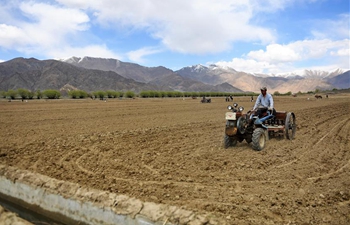SAN FRANCISCO, April 29 (Xinhua) -- Conservation projects that protect forests and encourage a diversity of plants and animals can provide many benefits to humans, but a new study indicates that improved human health is not among those benefits, at least when health is measured through the lens of infectious disease.
In a paper published this week in Philosophical Transactions of the Royal Society B, researchers said increased biodiversity, measured as the number of species and amount of forested land, appeared not associated with reduced levels of infectious disease.
In some cases, the researchers who analyzed the relationship between infectious diseases and their environmental, demographic and economic drivers in dozens of countries over 20 years noted disease burdens actually increased as areas became more forested over time.
Surprisingly, they found, increasing urbanization reduced disease, probably because cities bring people closer to medical care and give them greater access to vaccinations, clean water and sanitation.
"There are a lot of great reasons for conservation, but control of infectious disease isn't one of them," said lead author and parasite ecologist Chelsea Wood, an assistant professor in the School of Aquatic and Fishery Sciences at the University of Washington (UW).
"We're not going to improve public health by pushing a single button. This study clearly shows that -- at the country level -- conservation is not a disease-control tool."
Even though cities crowd people together, the net benefit of their services results in reductions of infectious disease.
"It seems pretty clear that urbanization is good for people's health -- at least when it comes to infectious disease. And that's good news, because the world is rapidly urbanizing," Wood was quoted as saying in a news release.
Relying on the UW-based Institute for Health Metrics and Evaluation's Global Burden of Disease database, a worldwide effort to document premature death and disability from hundreds of diseases and injuries from 1990 to the present, the researchers compared data on 24 infectious diseases with separate, published data on population density, wealth, bird and mammal species richness, forest cover, precipitation and other environmental measures to analyze the effects these factors had, if any, on disease burden per country.
Being the first to look at the association between biodiversity and disease over time, the study revealed no relationship between biodiversity, or number of species present, and the overall burden of infectious disease over the 20-year period.
But for each individual disease, ranging from malaria, dengue and rabies to typhoid, tuberculosis and leprosy, there was a unique set of drivers that were important in deciding whether burden increased or decreased over time.
For example, as rates of precipitation went up, so did the burden of "geohelminths," a group of gut parasites that includes hookworm, whipworm and roundworm.
Together, the geohelminths affect 1.5 billion people. Moist soil is an ideal environment for the development of these worms. Humans can become infected when they contact or accidentally ingest contaminated soil on unwashed vegetables.
"I hope this study encourages people to explicitly acknowledge the potential disease-related risks and benefits of conservation projects," Wood said. "The absolute last thing we want to do is a conservation project that gets people sick."

















